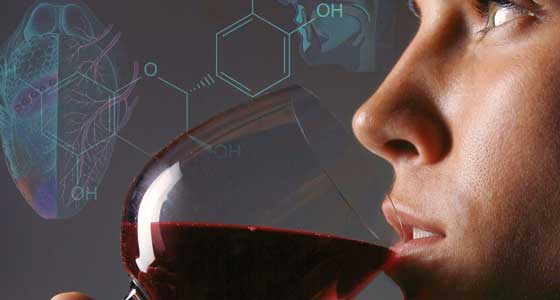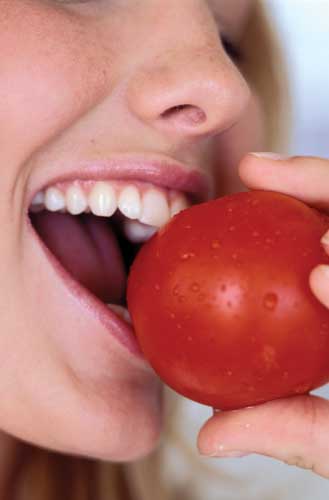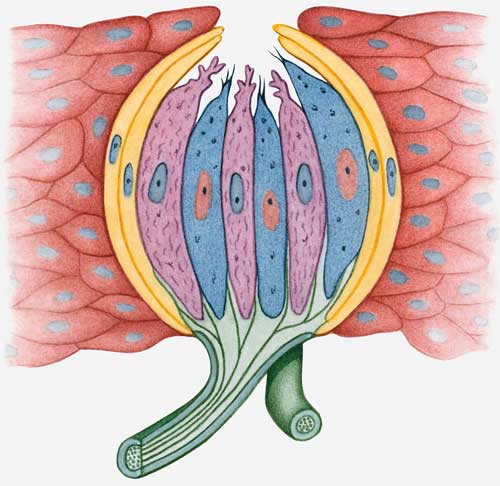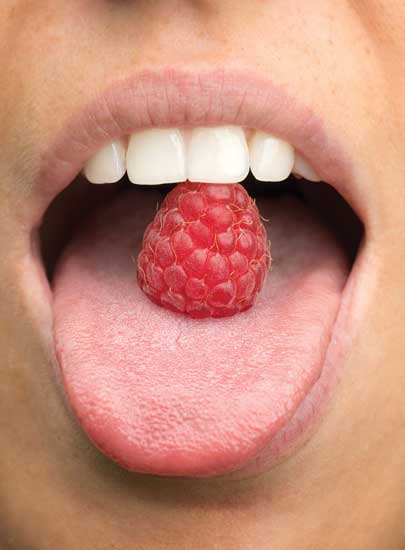Decoding the Science of Taste
Sweet. Sour. Salty. Savory. Bitter. Researchers are unlocking new secrets about the complicated mechanisms of taste, and their findings will shape product development and public health initiatives.

Robert Margolskee, director of the Monell Chemical Senses Center in Philadelphia, doesn’t like coffee, dark chocolate, or bitter beer. Since he heads a preeminent scientific institution dedicated to studying taste and smell, it’s not surprising that he can explain exactly why that is the case. Blame it on genetics, says Margolskee, who has a doctorate in molecular genetics as well as a medical degree. The researcher says he was recently genotyped and found that he possesses a particular configuration of taste receptor genes that makes him hypersensitive to certain bitter compounds. Which means you probably won’t find him in line at the local Starbucks ordering a dark roast double espresso anytime soon.
Taste tops the list of what consumers care about when deciding what to eat or drink, but as Margolskee’s bitterness aversion suggests, our genetic makeup has a lot to do with which tastes we find appealing and which ones we can’t tolerate. Life experience also shapes taste preferences. All of this has become much better understood in the past decade and a half thanks to advances in molecular biology and genetics research, but much remains unknown. Initiatives like those taking place at Monell, however, are providing insights into the ways in which the science of taste has the potential to shape our food choices, affect our metabolism, and usher in new, targeted approaches to product development that will yield foods and beverages tailored to meet consumers’ personal preferences and nutritional needs.
 “Taste is complicated,” Margolskee observes. “Part of it is that each taste quality—sweet, sour, salty, bitter, and umami—is almost like a separate sense. We have them all … in the same taste bud—which is the organ of taste and where it starts—but they’re all mixed together. It seems like they’re in different cells, and yet in some physiologic experiments, it also looks like the cells that respond best to sweet also respond to other stimuli, so there’s a certain amount of mixing going on. So right at the beginning, it’s a complicated sense.”
“Taste is complicated,” Margolskee observes. “Part of it is that each taste quality—sweet, sour, salty, bitter, and umami—is almost like a separate sense. We have them all … in the same taste bud—which is the organ of taste and where it starts—but they’re all mixed together. It seems like they’re in different cells, and yet in some physiologic experiments, it also looks like the cells that respond best to sweet also respond to other stimuli, so there’s a certain amount of mixing going on. So right at the beginning, it’s a complicated sense.”
In fact, Monell scientists point out that taste is even more complex than the senses of vision and hearing, which tend to be viewed as more important. Just three types of photoreceptors are responsible for color vision, for example, but humans have at least 25 different receptors to sense bitter tastes.
Bitterness receptors are important because bitter-tasting things often are toxic, so being sensitive to bitter tastes was critical for the survival of the species, explains Robin Dando, an assistant professor in the Cornell University Dept. of Food Science.
“Bitter things for the most part represent things that might be dangerous,” says Dando. “When food spoils, it becomes sour, so that would guide us away from things that are toxic or spoiled.” In taste science parlance, bitter and sour are described as “aversive” because humans tend not to like these tastes.
 The remaining three tastes—sweet, salty, and umami—are “appetitive” tastes—things we like. Taste preferences have evolved, says Gary Beauchamp, emeritus director of Monell, “because the taste system is the last decision point where you decide you’re going to take something into your body or reject it. … It’s making these major decisions: Is this calorically rich? Is this poison? Is this going to supply amino acids/protein?”
The remaining three tastes—sweet, salty, and umami—are “appetitive” tastes—things we like. Taste preferences have evolved, says Gary Beauchamp, emeritus director of Monell, “because the taste system is the last decision point where you decide you’re going to take something into your body or reject it. … It’s making these major decisions: Is this calorically rich? Is this poison? Is this going to supply amino acids/protein?”
“A taste for sweet in the natural world is a signal that there are calories there,” says Dando. “And in the past environment, until recent history, calories were a very good thing. You don’t survive without calories. The more that you could detect them and consume them, the better for you.” A salty taste, he notes, implies that something contains sodium or potassium, both of which are minerals that are important for the body’s functioning.
“And umami is the taste of protein,” Dando continues. “That’s what umani is—amino acids. We know that we need protein to survive. … So if things taste very savory to us, we know that there’s a lot of protein … a lot of amino acids, and it’s going to be good to consume.”
--- PAGE BREAK ---
How We Taste
The mechanism of taste starts on the tongue, where thousands of taste buds are concentrated in papillae—the tiny bumps that are easily visible if you stick your tongue out and look in a mirror. Taste buds are also located on the roof of the mouth and in the throat. Each taste bud includes about 50 to 100 specialized cells that contain taste receptors, which are activated when they come into contact with the chemical compounds in foods and beverages.
Information from the chemical stimulus within taste cells is translated into an electrical message that is relayed by taste nerves to the brain stem, where initial taste processing takes place. From there, impulses are relayed to other parts of the brain, where they affect conscious perception of taste and influence emotions and memories (Murray 2016). Another nerve that is critical in relaying important taste-related messages to the brain is the trigeminal nerve; it transmits information related to sensations of heat or burning (think capsaicin), cooling (menthol), and tingling (carbonated drinks).
Taste receptors aren’t limited to the oral cavity; they are found in many different parts of the body, including the gut, pancreas, lungs, and nose. Receptors in nontaste organs don’t “taste” like those in the tongue, but they play a variety of roles, many of which are still not understood. Because sweet taste receptors in the gut and pancreas are linked to metabolism, scientists are investigating their potential ability to play a therapeutic role in treating metabolic disorders like obesity and diabetes (Cuenca 2013). Bitter taste receptors in the intestines help protect us from poisoning by detecting toxic substances and prompting the body to expel them (vomiting, diarrhea) (Fox 2011). Scientists at Monell and the University of Pennsylvania also discovered that bitter taste receptors in the nose help fight sinus infections (Monell 2015a).
 Why We Savor Sweet
Why We Savor Sweet
Find it difficult to pass up cake and doughnuts? It’s not just a matter of willpower. We’re hardwired to love sweet tastes. “We’re probably fighting our biology,” says Margolskee. “There’s a drive to take in sweet and a drive to take in sweet that has calories.
“You can see it in the earliest stages in infants,” Margolskee continues. “If you give them sugar or a sweetened beverage, they will give you a little bit of a puckering smile, and they’ll lick and look happy. If you give them something bitter like quinine, they will bunch up their face … clench their mouth, and reject the food. … You can see stereotypical sweet and bitter response faces in the youngest infants, in chimpanzees, in newborn monkeys.” Even rats and mice have similar facial responses to sweet and bitter, he adds. Sweet tastes have the power to blunt babies’ experience of pain, which is why they are used as analgesics for babies who are undergoing pain-causing procedures like circumcision or blood tests (Owen 2015).
It probably doesn’t come as a surprise to hear that kids prefer sweeter tastes than adults or that sweetness perception varies significantly from person to person. A recent Monell research project explored the sweet taste detection threshold—which is defined as the lowest detectable level of sucrose—in 216 children between the ages of 7 and 14. Children were asked to distinguish between the taste of cups of plain distilled water and varying concentrations of sugar solutions. The lowest concentration at which the child could distinguish the sugar solution from the water was the child’s sweet detection threshold. The study found that the most sensitive child could detect sweetness with only 0.005 teaspoons of sugar dissolved in the water; the least sensitive participant required much more—3 teaspoons—in order to be able to detect sweetness (Monell 2015b). Children who don’t easily detect sweetness may find it harder to deal with sugar reduction because they are getting less of a “sweet signal” from sugar; they require more sugar in order to find products palatable, explains study author Danielle Reed, a behavioral geneticist and associate director of the research center (Monell 2015b).
The sweetness detection research produced some unanticipated results. Reed says the researchers had assumed that obese children would be less sensitive to sugar and would require more of it than leaner children to experience a pleasing effect, but the opposite was true. Children who had more body fat were better able to detect sweet tastes at lower concentrations.
“That was a big surprise for us,” says Reed. “The sweet receptor that responds to sugar on your tongue is found in other parts of the body, particularly fat cells,” she continues. “So the idea is if you’re very sensitive to sugar on the tongue, that sensitivity might be reflected elsewhere in the body, so the fat cells might be more inclined to recognize and suck up sugar for lipogenesis, [that is] to make fat.”
 Monell research has also shown that we tend to cling fervently to our sweet preferences. In another recent study, test subjects reduced sugar consumption by 40% for three months and were asked to periodically evaluate the sweetness intensity and pleasantness of vanilla puddings and raspberry beverages. After three months on the diet, the sugar-restricted participants’ perception of sweetness changed—they rated most puddings and beverages as sweeter than members of the control group did, says Monell sensory psychologist Paul Wise. But their sweetness preference—the level of sweetness they most preferred—was unchanged. This contrasts with earlier Monell studies on salty taste preferences, which can be modified over time. “I can tell you that people are a lot more stubborn about reducing their sugar [consumption] than they are about salt,” Wise summarizes.
Monell research has also shown that we tend to cling fervently to our sweet preferences. In another recent study, test subjects reduced sugar consumption by 40% for three months and were asked to periodically evaluate the sweetness intensity and pleasantness of vanilla puddings and raspberry beverages. After three months on the diet, the sugar-restricted participants’ perception of sweetness changed—they rated most puddings and beverages as sweeter than members of the control group did, says Monell sensory psychologist Paul Wise. But their sweetness preference—the level of sweetness they most preferred—was unchanged. This contrasts with earlier Monell studies on salty taste preferences, which can be modified over time. “I can tell you that people are a lot more stubborn about reducing their sugar [consumption] than they are about salt,” Wise summarizes.
Sweetness-boosting ingredients like those from San Diego–based biotech firm Senomyx could help. The company has identified several compounds that function not as sugar replacers but rather as flavor modifiers that enhance sweetness perception. The compounds interact with the taste buds, causing them to respond more efficiently to sweet tastes. This allows product formulators to reduce sugar content while maintaining sweetness.
--- PAGE BREAK ---
Getting Smart About Salt
 Because it is such an important public health issue, dietary sodium gets plenty of press, and salt is a major research focus at Monell. “Salt is this magic ingredient, but clearly we’re consuming much more salt than most people need,” says Beauchamp. He points out that in addition to its obvious taste appeal, salt delivers a variety of more subtle benefits in food formulations, such as reducing bitterness and releasing sweetness.
Because it is such an important public health issue, dietary sodium gets plenty of press, and salt is a major research focus at Monell. “Salt is this magic ingredient, but clearly we’re consuming much more salt than most people need,” says Beauchamp. He points out that in addition to its obvious taste appeal, salt delivers a variety of more subtle benefits in food formulations, such as reducing bitterness and releasing sweetness.
Replacing salt in product formulations isn’t easy, however, because there aren’t a lot of effective substitutes for common table salt (sodium chloride). Product developers frequently turn to another salt, potassium chloride, but it is associated with off-tastes.
 Monell researcher Brian Lewandowski, a neurophysiologist, has devoted much of the past five years to exploring the mechanism for salt taste perception and finding ways to enhance it. “Salty taste, unlike other basic tastes, actually has two separate pathways that are responsible for detecting salt and sending that information on to the brain,” Lewandowski explains.
Monell researcher Brian Lewandowski, a neurophysiologist, has devoted much of the past five years to exploring the mechanism for salt taste perception and finding ways to enhance it. “Salty taste, unlike other basic tastes, actually has two separate pathways that are responsible for detecting salt and sending that information on to the brain,” Lewandowski explains.
The first mechanism is well understood and occurs via a channel known as ENaC (epithelial sodium channel). Scientists know that a second pathway exists, but it has not yet been identified. The second pathway responds to sodium and other salts (including potassium chloride) and provides information about the intensity of salt taste and the unpleasantness associated with strongly salty stimuli.
“One of the other things that makes salt taste unique and ties into these two pathways … is that unlike the other tastes, salt starts off as appetitive, so it tastes good at low concentrations, but at high concentrations, we don’t like it,” says Lewandowski. “It tastes like sea water.”
Lewandowski and a team of Monell scientists recently published the results of a research project that identified taste cells involved in the second salt taste pathway, and they are working now to identify that pathway and pinpoint the mechanism by which it operates.
Because it’s unlikely that researchers will be able to identify viable salt substitutes akin to the large array of alternative sweeteners that are available for product formulators, industry efforts will likely be concentrated on finding taste enhancers to increase saltiness perception, Beauchamp and Lewandowski agree. Getting to this point will be no easy feat, however. “It is kind of a holy grail of taste research right now,” says Beauchamp. “If it were a simple problem, it would have been figured out a long time ago.”
Taste + Smell = Flavor
No discussion of taste can be complete without considering olfaction, the sense of smell. Taste and smell work together to establish the flavor of a food or beverage, and smell plays the primary role. Scientists who study the senses frequently use the “jelly bean test” to make this point. Take two red jelly beans—one strawberry and one cherry. If you taste them while holding your nose, your taste buds will tell you that they are sweet, but you won’t be able to tell which one is strawberry and which one is cherry. That requires being able to smell them—which illustrates just how important aroma is in establishing flavor.
Margolskee offers this illustration of the same point. “It you take a bite out of an apple, that tastes very different than taking a bite out of a potato,” he says. “They’re both starchy and they both have a certain amount of sweetness, even a little bit of saltiness and sourness, but most of the flavor … is from the olfactory response.”
In real-world scenarios, the relationship between taste and smell tends to be seamless. “In flavor, in the average, everyday experience, you’re not going to be distinguishing the two,” says Wise. “[Both] will be part of the flavor experience.”
It’s critical for product developers to be well-versed in how both taste and smell function, emphasizes Barb Stuckey, president of product development and design firm Mattson, Foster City, Calif., and author of the book Taste. When formulating a product, she explains, “you have to understand the difference between taste and smell in order to understand which levers need to be adjusted.”
Olfaction occurs in two ways: directly through the nose, which is orthonasally, or retronasally, which is “when you’re chewing the food and vaporizing chemicals in the food and then stimulating the nose from the back,” Margolskee says. With our large assortment of olfactory receptors, humans are capable of identifying thousands of odors. While much of the sense of taste is innate, smell is a more “plastic” sense, according to Wise. “It’s driven so much by learning and experience,” he says.
Aromas and taste can influence each other in some interesting ways. For example, Wise says that experiments have shown that “taste will generally enhance aroma, but only if those tastes are nutritive.” Thus, a taste that reflects a nutrient the body needs, such as savory amino acids, salt, or sugar, will enhance the intensity of the retronasal smell, he explains. “The hypothesis,” says Wise, “is that it is helping to establish the identity of the food more saliently as a source of those nutrients.”
--- PAGE BREAK ---
Experiments at Monell have also shown that odors can suppress and enhance tastes, Wise continues. “If you put a burnt odor in the nose, that suppresses the intensity of a sweet taste. If you put a sweet odor in the nose, that slightly suppresses the intensity of a bitter taste, which might be useful in formulations of anything you want to ameliorate the bitterness of, particularly medications for children,” he says. “You can add a little bit of aroma, and that will help the medicine go down a little bit better.”
 Sensory experts have speculated that it may be possible to help consumers cut calories by creating sugar-reduced products that they perceive as sweet via the addition of sweetness-enhancing flavor volatiles (Owen 2015). “People have patented things where they essentially fool people into thinking that they’re tasting sweeter, but they’re only smelling sweeter,” says Dando. He’s not convinced that such an approach is a great idea, however, because it would potentially change a product’s entire flavor profile.
Sensory experts have speculated that it may be possible to help consumers cut calories by creating sugar-reduced products that they perceive as sweet via the addition of sweetness-enhancing flavor volatiles (Owen 2015). “People have patented things where they essentially fool people into thinking that they’re tasting sweeter, but they’re only smelling sweeter,” says Dando. He’s not convinced that such an approach is a great idea, however, because it would potentially change a product’s entire flavor profile.
When Irritation Can Be a Good Thing
In addition to taste and smell, a third sensory system—chemical irritation—plays an important part in how we experience food that is hot and spicy as well as things that are cool or tingling. This system revolves around the trigeminal nerve, a nerve that responds to chemical stimuli in the mouth, throat, nose, and even the eyes, which explains why a big bowl of Texas-style chili can cause your nose to run and eyes to water.
A family of ion channels called transient receptor potential (TRP) channels located on trigeminal nerve endings respond to compounds like capsaicin, horseradish, and wasabi, as well as the cooling sensation of menthol and the tingling bite of carbonation. Perhaps it’s not so surprising that the TRP receptor responsible for the crazily pungent sensation a taste of wasabi can trigger in your nasal passages also responds to chemical irritants like tear gas and air pollution (Hamilton 2015).
Scientists have learned a lot about TRP receptors in the past decade or so. Researchers hope that their insights will eventually lead to breakthroughs in medications that relieve pain by blocking a TRP receptor’s normal response (Hamilton 2015). Wise says that one of the fascinating things about TRP receptors is that they not only respond to chemical compounds but also are sensitive to hot and cold temperatures.
Because people often suffer a loss of appetite as their senses of smell and taste diminish with age, Wise says that triggering chemical irritation responses may help make food more palatable for older people. “There’s a lot of talk about using irritants to spice up foods to make them more interesting to the elderly to help [them] maintain nutritional status,” he notes.
 Taste Science and Product Development
Taste Science and Product Development
Individual taste preferences begin to develop before birth. One often-cited Monell study by biopsychologist Julie Mennella found that pregnant women who drank carrot juice in their third trimester or while breastfeeding had babies who liked carrot-flavored cereal more than those whose mothers did not partake of carrot juice (Mennella et al. 2001). Virginia Utermohlen Lovelace, a former pediatrician and recently retired Cornell University nutritional sciences associate professor, notes that taste buds develop when fetuses are 12 weeks old. Because an unborn baby swallows the mother’s amniotic fluid, “they’re tasting and experiencing the mother’s meals,” she says. Later life experience continues to shape preferences. Just ask anyone who has a lifelong aversion to a specific food after consuming it and coming down with a nasty case of food poisoning.
Each of us inherits a gene pool that helps determine what we can taste and smell. New research from Monell shows, for example, that sweetness taste perception is about 30% genetically influenced (Monell 2015c). Tongue anatomy plays a role too; everyone has a different number of taste buds, and taste bud density decreases with age.
As for aroma perception, Monell researcher Wise offers the example of how individuals respond to the smell of androstenone (a mating pheromone for pigs). “There are huge individual difference that have been tracked to a particular receptor,” says Wise. “If you express one form of the [receptor] protein, you’re sensitive to it, and it smells horrible. And if you express another form, you’re insensitive and at a high enough concentration, it might smell pleasant.
“Probably any given person … will be insensitive to something,” Wise continues. “So we each do live slightly in our own sensory world.”
--- PAGE BREAK ---
 Senses other than smell also affect how something tastes. Last year Cornell’s Dando and graduate student Kimberly Yan published the findings of a study they conducted to see how noise levels comparable to those airline passengers experience in flight affected perception of the five basic tastes. Dando and Yan found that the test subjects’ perceptions of salty, bitter, and sour taste were not affected by noise, but noise reduced sweetness perception. And subjects in a noisy environment perceived umami taste more intensely than their counterparts in a quiet control environment (Yan and Dando 2015). Thus companies that are developing airline meals may wish to consider testing their formulations in noisy environments and optimizing recipes for such environments in order to better serve air travelers, says Dando.
Senses other than smell also affect how something tastes. Last year Cornell’s Dando and graduate student Kimberly Yan published the findings of a study they conducted to see how noise levels comparable to those airline passengers experience in flight affected perception of the five basic tastes. Dando and Yan found that the test subjects’ perceptions of salty, bitter, and sour taste were not affected by noise, but noise reduced sweetness perception. And subjects in a noisy environment perceived umami taste more intensely than their counterparts in a quiet control environment (Yan and Dando 2015). Thus companies that are developing airline meals may wish to consider testing their formulations in noisy environments and optimizing recipes for such environments in order to better serve air travelers, says Dando.
Dando is also interested in exploring the ways in which an individual’s metabolism or level of exertion may influence taste perception. “Let’s say, for instance, if you put on some weight, do you taste things differently then?” he asks. “Or if you’ve done some extreme exercise?” As research provides new insights into how factors like this may influence taste, it could open the door for foods that are “tailored for specific situations rather than for a broader general public,” Dando reflects.
Given the extent of individual variation in sensory perception and the many factors that can influence it, it’s simply not possible to create products that will appeal to everyone. Stuckey says most product developers target that 50% or so of the population described as tasters—those with middle-of-the-road taste sensibilities. “You design products to [appeal to] those people,” Stuckey notes. “The ones at the low end don’t perceive much in the way of taste. They’re not as picky as the ones at the supertaster end of things. And generally you don’t design your product for supertasters because they are so picky that they will generally find their own products. You are designing for the center of the bell curve.”
Individual sensory variation also goes a long way toward explaining why it’s important for food and beverage manufacturers to offer multiple flavor varieties within a product line. “A good example is Lay’s potato chips, which offers a new flavor practically every couple of months,” Stuckey notes. “If you want something super spicy, they’ve got something for you. If you want something a little sweeter and less spicy, they’ve got something for you. If you like really sour, they have something for you.”
Sensory experts expect to see the trend toward more personalization of product assortments continue. Not only does it make sense from a sensory perspective, but it’s also supported by a convergence of food industry trends—everything from online retailing, which provides a home for a larger assortment of products than a conventional retailer can stock on store shelves, to the rise of niche brands from entrepreneurial companies.
“What we’re seeing in the industry right now—which is a very macro trend—is the toppling over of the big food brands, which have generally tried to appeal to everyone,” says Stuckey. “In their place are these smaller, local, targeted artisan brands that speak to a smaller percent of the population and as a result, because they’re not trying to focus on everyone, they’re better able to hone in on a particular consumer.
“This is the wave of the future,” says Stuckey. “It’s never going to go back. We’re never going to have every single household in America eating the same thing like we did in the ’60s and ’70s.” And that, of course, makes perfect sense given the sensory diversity of the population.
Monell’s Food and Beverage Industry Connection
Although researchers at the Monell Chemical Senses Center in Philadelphia stay focused on basic research (versus industry-oriented applied research projects), the institute partners with corporate sponsors, who provide funding and, in return, get early access to research findings and participate in educational programming. Monell’s current roster of corporate sponsors numbers about 45 companies, including many in the food, beverage, and flavor industries. Industry provides about 40% of Monell’s funding, support that is especially important as some federal funding sources dry up.
“It’s a great two-way partnership with the sponsors,” says Carol Christensen, Monell’s director of institutional advancement. “We share with them what’s new in taste and smell, and they share with us what … issues they face that have some bearing on the chemical senses.”
One of Monell’s current research projects supported by industry focuses on salty taste detection mechanisms. Another, which recently concluded, investigated sweet taste adaptation—looking into the reasons why sweet taste lasts longer in beverages that are sweetened with sugar than in those formulated with noncaloric high-intensity sweeteners.
“We probed the sweet taste mechanism in the oral cavity, and some of those probes were sweeteners we would never think of using,” notes Christensen. “And that’s where industry gave us a window. And, in fact, we discovered together that one of these sweeteners that we tried behaved more like sucrose than like a noncaloric sweetener. We were surprised by that.”
Next, Christensen says, Monell hopes to assemble an industry-sponsored consortium that will explore sensory perception of fat.
--- PAGE BREAK ---
 In the Fast Lane of Taste Science Research
In the Fast Lane of Taste Science Research
At San Diego–based biotech firm Senomyx, taste science research has been accelerated to produce an assortment of taste modification ingredients that work to make sweet tastes sweeter, savory tastes more savory, and bitter tastes less bitter.
Founded in 1998 by pioneering taste researcher Charles Zuker and other scientists, the company has a patented technology that mimics the function of taste bud receptors. That technology is used with a high-speed assay process that allows Senomyx to screen potential flavor ingredients at a rate that is far faster than traditional methods.
“We have compound libraries here at Senomyx, which are very diverse sets of different molecules, and essentially, the platform of our company is screening those molecules with an assay where we express those taste receptors such that we can focus on the interaction between the receptors and hundreds of thousands or millions of different molecules,” explains Tanya Ditschun, senior director of food science and technology at Senomyx.
Ditschun says Senomyx can screen more than 40,000 molecular compounds in a week, thus automating much of the work that is traditionally done by sensory taste panels. “You put 40,000 cups in front of a taste panelist and you’ve got yourself a nightmare,” says Ditschun. She adds, however, that once the automated method identifies potential new flavor ingredients, sensory panels are used to refine the screening process.
To date, Senomyx has commercialized four sweetness modifiers as well as a bitter blocker and two savory taste modifiers, all of which are FEMA GRAS approved. PepsiCo has announced plans to use one of Senomyx’s Sweetmyx sweetness taste boosters in Manzanita Sol, an apple-flavored soda targeted to Hispanic consumers, as well as in Mug root beer in two test markets (Latif 2015).
Ditschun notes that Senomyx’s Bittermyx bitter blocker and Sweetmyx sweetness enhancers facilitate the development of a variety of healthful products by allowing for sugar reduction of up to 50% and also by blocking the bitter taste of some healthful but not-so-tasty plant-based compounds. “There are a lot of healthful compounds out there in foods that are good for us but don’t taste very good,” she says. Senomyx’s Savorymyx savory taste enhancers allow product developers to reduce monosodium glutamate in formulations.
The company also is working hard to unravel the complicated science around saltiness taste perception, but those efforts have so far proven elusive. “The goal we’re focusing on is to use our taste-testing platform to validate a specific protein responsible for salt taste,” says Ditschun.
Mary Ellen Kuhn is executive editor of Food Technology magazine ([email protected]).
References
Cuenca, L. 2013. “The Bittersweet Truth of Sweet and Bitter Taste Receptors.” Science in the News, Harvard University. http://sitn.hms.harvard.edu/flash/2013/the-bittersweet-truth-of-sweet-and-bitter-taste-receptors.
Fox, D. 2011. “Full Body Taste.” Society for Science & the Public, March 23. https://student.societyforscience.org/article/full-body-taste.
Hamilton, J. 2015. “Sushi Science: A 3-D View of the Body’s Wasabi Receptor.” NPR Health Shots, April 8. http://www.npr.org/sections/health-shots/2015/04/08/398065961/sushi-science-a-3-d-view-of-the-bodys-wasabi-receptor.
Latif, R. 2015. “PepsiCo to Use Sweetmyx Flavor Enhancer in Mug Root Beer, Manzanita Sol.” BevNET, Aug. 28. http://www.bevnet.com/news/2015/pepsico-to-use-sweetmyx-flavor-enhancer-in-mug-root-beer-manzanita-sol.
Mennella, J., C. P. Jagnow, and G. K. Beauchamp. 2001. “Prenatal and Postnatal Flavor Learning in Human Infants.” Pediatrics 107(6): E88. http://pediatrics.aappublications.org/content/107/6/e88.full.
Monell. 2015a. “Bitter Taste Sensitivity May Predict Surgical Outcome in Certain Chronic Rhinosinusitis Patients.” Press release, Nov. 12. Monell Chemical Senses Center, Philadelphia. monell.org.
Monell. 2015b. “Children’s Ability to Detect Sugar Varies Widely.” Press release, Dec. 14.
Monell. 2015c. “Some Like It Sweet, Others Not So Much: It’s Partly in the Genes.” Press release, July 17.
Murray, M. 2016. “Our Chemical Senses: 2. Taste.” https://faculty.washington.edu/chudler/taste.html.
Owen, D. 2015. “Beyond Taste Buds: The Science of Delicious.” National Geographic, Nov. 13. http://ngm.nationalgeographic.com/2015/12/food-science-of-taste-text.
Yan, K. S. and R. Dando. 2015. “A Crossmodal Role for Audition in Taste Perception.” J. Exp. Psychol. Advance online publication. http://dx.doi.org/10.1037/xhp0000044.
